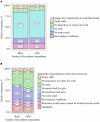Knowledge, attitudes, and practices of hygiene among children in schools of Central Kazakhstan: a cross-sectional study
- PMID: 40529691
- PMCID: PMC12170687
- DOI: 10.3389/fpubh.2025.1595672
Knowledge, attitudes, and practices of hygiene among children in schools of Central Kazakhstan: a cross-sectional study
Abstract
Background: The issue of good hygiene among school-aged children is crucial for public health and sustainable development. Despite the availability of global studies covering countries with different socio-economic conditions, there is a lack of local data reflecting the specifics of Kazakhstan. Therefore, the aim of this study was to determine the level of knowledge, attitude and practice of schoolchildren regarding personal and public hygiene in schools of Central Kazakhstan.
Methods: School-based cross-sectional study was conducted from September 2024 to December 2024 in six schools of Central Kazakhstan. The simple random sampling technique was used to select the school. A computer-generated sequence of random numbers was used to randomly select students. Subsequently, 382 students aged 11-18 years were selected from a total of 72.179 students. The data were collected through a questionnaire using the online Google forms service. It consisted of socio-demographic data and information on knowledge and practice of personal and public hygiene of students in schools. The data were computerized. A statistical analysis of the data was carried out using SPSS (Statistical Package for Social Sciences). P < 0.05 with a 95% confidence interval was considered statistically significant.
Results: The results showed significant gender differences in hygiene knowledge and behavior. More than 90% of students knew about the basic rules of personal hygiene, with girls demonstrating higher knowledge and practices compared to boys (e.g., brushing teeth twice a day: 97% of girls vs. 87.8% of boys, P < 0.001). Hand washing before eating was known to 99% of girls and 92.8% of boys (P < 0.05). In terms of hygiene practices, girls brushed their teeth twice a day more often (68.7% of girls vs. 57.5% of boys, P < 0.05). However, there were differences in hygiene compliance at school due to insufficient infrastructure, such as lack of soap, hot water and poor condition of restrooms.
Conclusion: The study revealed a high level of knowledge about personal hygiene among school students in Karaganda, especially among girls. However, practical compliance with hygiene rules was often limited by infrastructural problems in schools. Strengthening hygiene education programs and improving sanitary conditions in educational institutions is necessary.
Keywords: parents; personal hygiene; public hygiene; schoolchildren; schools.
Copyright © 2025 Kuandyk, Omarova and Delellis.
Conflict of interest statement
The authors declare that the research was conducted in the absence of any commercial or financial relationships that could be construed as a potential conflict of interest.
Figures
Similar articles
-
Hand hygiene practices during the COVID-19 pandemic and associated factors among barbers and beauty salon workers in Ethiopia.PLoS One. 2022 Jul 1;17(7):e0269225. doi: 10.1371/journal.pone.0269225. eCollection 2022. PLoS One. 2022. PMID: 35776735 Free PMC article.
-
Menstrual hygiene practices among high school girls in urban areas in Northeastern Ethiopia: A neglected issue in water, sanitation, and hygiene research.PLoS One. 2021 Jun 9;16(6):e0248825. doi: 10.1371/journal.pone.0248825. eCollection 2021. PLoS One. 2021. PMID: 34106948 Free PMC article.
-
Menstrual hygiene practices and associated factors among Indian adolescent girls: a meta-analysis.Reprod Health. 2022 Jun 23;19(1):148. doi: 10.1186/s12978-022-01453-3. Reprod Health. 2022. PMID: 35739585 Free PMC article.
-
Systematic review of menstrual health and hygiene in Nepal employing a social ecological model.Reprod Health. 2022 Jun 30;19(1):154. doi: 10.1186/s12978-022-01456-0. Reprod Health. 2022. PMID: 35773696 Free PMC article.
-
Menstrual hygiene management practices and associated factors among primary school girls in Gakenke district, Rwanda.BMC Res Notes. 2025 Aug 20;18(1):366. doi: 10.1186/s13104-025-07429-3. BMC Res Notes. 2025. PMID: 40835931 Free PMC article.
References
-
- Ilesanmi O. Knowledge and practices of personal hygiene among senior secondary school students of Ambassadors college, Ile- Ife, Nigeria. Texila Int J. (2016) 4:625–36. 10.21522/TIJPH.2013.04.04.Art055 - DOI
-
- Ali MY, Rahman MM, Siddiqui MH. Exploring degree of awareness about healthcare and hygienic practices in Secondary School Students residing in semi- urban areas of Bangladesh. CBMJ. (2013) 2:55–62. 10.3329/cbmj.v2i1.14186 - DOI
-
- Department of Drinking Water Supply, Ministry of Rural Development, Government of India . Technical note series. In: School Water Supply, Sanitation & Hygiene Education: India. New Delhi: Department of Drinking Water Supply; (2004). Available online at: http://www.ddws.gov.in/sites/upload_files/ddws/files/pdf/pdf/TechNoteSSH... (accessed on 7 September, 2024).
MeSH terms
LinkOut - more resources
Full Text Sources



